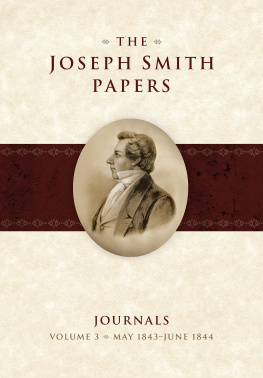Andrew H. Hedges (ed.) - May 1843–June 1844
Here you can read online Andrew H. Hedges (ed.) - May 1843–June 1844 full text of the book (entire story) in english for free. Download pdf and epub, get meaning, cover and reviews about this ebook. City: Salt Lake City, year: 2015, publisher: The Church Historian’s Press, genre: Religion. Description of the work, (preface) as well as reviews are available. Best literature library LitArk.com created for fans of good reading and offers a wide selection of genres:
Romance novel
Science fiction
Adventure
Detective
Science
History
Home and family
Prose
Art
Politics
Computer
Non-fiction
Religion
Business
Children
Humor
Choose a favorite category and find really read worthwhile books. Enjoy immersion in the world of imagination, feel the emotions of the characters or learn something new for yourself, make an fascinating discovery.
- Book:May 1843–June 1844
- Author:
- Publisher:The Church Historian’s Press
- Genre:
- Year:2015
- City:Salt Lake City
- Rating:5 / 5
- Favourites:Add to favourites
- Your mark:
- 100
- 1
- 2
- 3
- 4
- 5
May 1843–June 1844: summary, description and annotation
We offer to read an annotation, description, summary or preface (depends on what the author of the book "May 1843–June 1844" wrote himself). If you haven't found the necessary information about the book — write in the comments, we will try to find it.
May 1843–June 1844 — read online for free the complete book (whole text) full work
Below is the text of the book, divided by pages. System saving the place of the last page read, allows you to conveniently read the book "May 1843–June 1844" online for free, without having to search again every time where you left off. Put a bookmark, and you can go to the page where you finished reading at any time.
Font size:
Interval:
Bookmark:

2015 by Intellectual Reserve, Inc. All rights reserved.
The Church Historians Press is an imprint of the Church History Department
of The Church of Jesus Christ of Latter-day Saints, Salt Lake City, Utah
and a trademark of Intellectual Reserve, Inc.
www.josephsmithpapers.org
The Joseph Smith Papers Project is endorsed by
the National Historical Publications and Records Commission.
Art direction: Richard Erickson.
Cover design: Scott Eggers. Interior design: Richard Erickson and Scott M. Mooy.
Typography: Alison Palmer.
E-book: Ben Ellis Godfrey.
Library of Congress Cataloging-in-Publication Data
Smith, Joseph, 18051844.
Journals series / Dean C. Jessee, Mark Ashurst-McGee, Richard L. Jensen, volume editors. p. cm. (The Joseph Smith papers)
Includes bibliographical references and index.
ISBN 978-1-57008-849-0 (hardbound: alk. paper; v. 1)
ISBN 978-1-60908-737-1 (hardbound: alk. paper; v. 2)
ISBN 978-1-62972-147-7 (hardbound: alk. paper; v. 3)
1. Smith, Joseph, 18051844Diaries. 2. Mormon ChurchPresidentsBiography.
3. Church of Jesus Christ of Latter-day SaintsPresidentsBiography. 4. Mormon Church HistorySources. 5. Church of Jesus Christ of Latter-day SaintsHistorySources.
I. Jessee, Dean C. II. Ashurst-McGee, Mark. III. Jensen, Richard L. IV. Title. V. Series.
BX8695.S6A3 2008 289.3092dc22 [B] 2008037101
Printed in the United States of America on acid-free paper.
10 9 8 7 6 5 4 3 2 1
The Joseph Smith Papers
E DITORIAL B OARD
Steven E. SnowMarcus B. NashRichard E. Turley Jr.Reid L. NeilsonMatthew J. GrowRonald K. EsplinJeffrey N. WalkerN ATIONAL A DVISORY B OARD
Richard Lyman BushmanTerryl L. GivensDean C. JesseeLaurie Maffly-KippSusan Holbrook PerdueStephen J. SteinHarry S. StoutM ANAGING H ISTORIAN
Matthew C. GodfreyA SSOCIATE M ANAGING H ISTORIAN
Robin Scott JensenE DITORIAL M ANAGER
R. Eric SmithA SSOCIATE E DITORIAL M ANAGERS
Nathan N. WaiteRiley M. LorimerS ENIOR R ESEARCH AND R EVIEW E DITOR
Richard L. JensenC ONTRIBUTORS TO T HIS V OLUME
E DITORIAL S TAFF
Constance Palmer Lewis, Lead EditorAlison PalmerShannon KellyLeslie ShermanD OCUMENT S PECIALIST
Dean C. JesseeR ESEARCH AND R EVIEW E DITORS
Joseph JohnstunRichard Llyod AndersonContents
Journals, May 1843June 1844
Reference Material
Organizational ChartsIllustrations and Maps
Textual Illustrations
Contextual Illustrations
Maps
Other Visuals


VOLUME 3 INTRODUCTION
Nauvoo Journals, May 1843June 1844
The final fourteen months of Joseph Smiths life were marked by important developments in the growth of Nauvoo, Illinois, and in the doctrine and practices of The Church of Jesus Christ of Latter-day Saints. These months were some of the busiest and most complex of Joseph Smiths life, as he functioned in his roles of president and trustee-in-trust of the church, mayor of Nauvoo, lieutenant general of the Nauvoo Legion, and candidate for the United States presidency. During this time, threats and violence against Joseph Smith and other members of the church increased, culminating in the murder of Joseph and his brother Hyrum in Carthage, Illinois, on 27 June 1844. The journals of Joseph Smith presented in this volume are an essential source for understanding this critical period of Mormon history as well as the life and thought of the churchs founding leader in the time leading up to his death.
Joseph Smiths journals during this period were kept exclusively by his private secretary, Willard Richards. Richards had been one of the principal writers for Smiths earlier Nauvoo journals, and by September 1843 he was also serving as the church historian, church recorder, Nauvoo city recorder, and clerk of the municipal court. Until late in the journal, many entries document relatively few eventsoften only onefor each day rather than provide a comprehensive account of Joseph Smiths activities. Most entries in Richardss own journal for this period are even shorter, suggesting that the brevity of the entries in Joseph Smiths journal resulted more from Richardss journal-keeping style than from a lack of familiarity with Smiths activities. Because of Richardss terse style, we often know more about Smiths activities through other individuals journals and other sources than we do through his own journal. Longer, more detailed entries toward the end of the journal probably resulted from Richardss own interest in the growing number and seriousness of the threats against Joseph Smith beginning in January 1844. Unless otherwise noted, the first-person pronouns that occur in the journal refer to Joseph Smith and probably reflect Richardss conscious effort to make this document Smiths personal journal.
Though Richards appears to have either participated in or witnessed most of the events he documented, at times he wrote retrospectively or from secondhand information.
The trip to Dixon was ill timed. That same month, a special term of the circuit court in Daviess County, Missouri, indicted Joseph Smith for treason committed during the Mormon War in 1838. Based on the indictment, Missouri governor Thomas Reynolds issued a requisition to Illinois governor Thomas Ford calling for Smiths extradition to Missouri for trialthe third such call to return Joseph Smith to Missouri in as many years. The requisition resulted in his arrest on 23 June 1843, news of which began a massive rescue effort in Nauvoo that ended with Smiths release at a habeas corpus hearing before the Nauvoo Municipal Court on 1 July.
Because of Richardss physical separation from Joseph Smith during much of the third extradition attempt, little of this drama appears in the journal. Later entries and sources, however, indicate Smiths continued concern about enemies in Missouri. Referencing the three extradition attempts, for example, the Nauvoo City Council passed an ordinance on 8 December 1843 stating that anyone found guilty of attempting to arrest Joseph Smith or others for alleged activities in Missouri in the 1830s would be incarcerated for life in the city prison.
Former and current difficulties with Missouri lay behind several other petitions issued from Nauvoo during this period. Between December 1843 and the end of February 1844, Joseph Smith and others petitioned several statesVermont, New York, Maine, Pennsylvania, Massachusetts, and Tennesseeto use their influence to help force Missouri to recompense the Mormons for the losses they suffered there in the 1830s. Like earlier appeals to Congress, none of these efforts resulted in any tangible aid for the Saints.
In a separate action, Joseph Smith instructed the Quorum of the Twelve Apostles in February 1844 to send a small exploring party to the western reaches of the continent to find a location where the Saints could move, build a city, and have a governme[n]t of [their] own. Within six weeks, some twenty-nine men either volunteered for the expedition or were assigned to go.
The Council of Fifty met on sixteen occasions between March and the end of May 1844, often for the better part of an entire day. In most cases, Willard Richards recorded very little about the councils proceedings in Joseph Smiths journal, even though both men attended the meetings. Extensive minutes kept by William Clayton, however, provide details about the councils discussions and plans. According to Sidney Rigdon, a member of the council as well as a counselor in the churchs governing First Presidency, the groups ultimate goal was to form a theocracy according to the will of Heaven, planted without any intention to interfere with any government of the world.... We will hunt a spot somewhere on the earth where no other government has jurisdiction and cannot interfere with us and there plant our standard.
Next pageFont size:
Interval:
Bookmark:
Similar books «May 1843–June 1844»
Look at similar books to May 1843–June 1844. We have selected literature similar in name and meaning in the hope of providing readers with more options to find new, interesting, not yet read works.
Discussion, reviews of the book May 1843–June 1844 and just readers' own opinions. Leave your comments, write what you think about the work, its meaning or the main characters. Specify what exactly you liked and what you didn't like, and why you think so.











